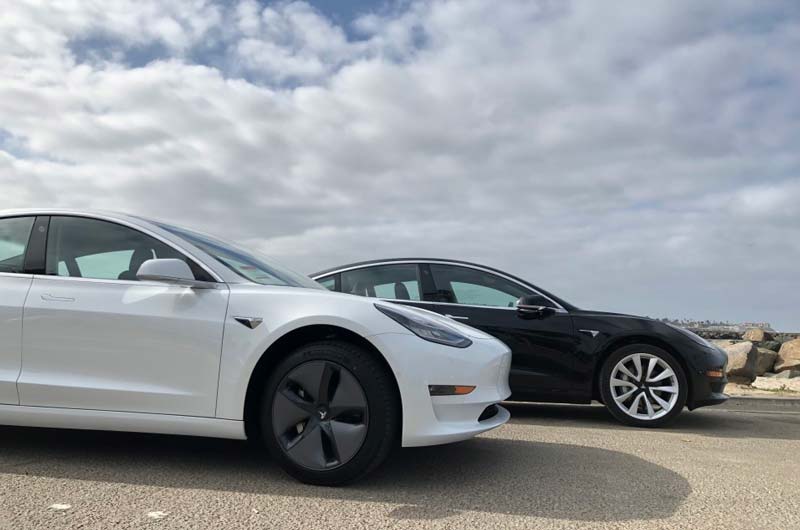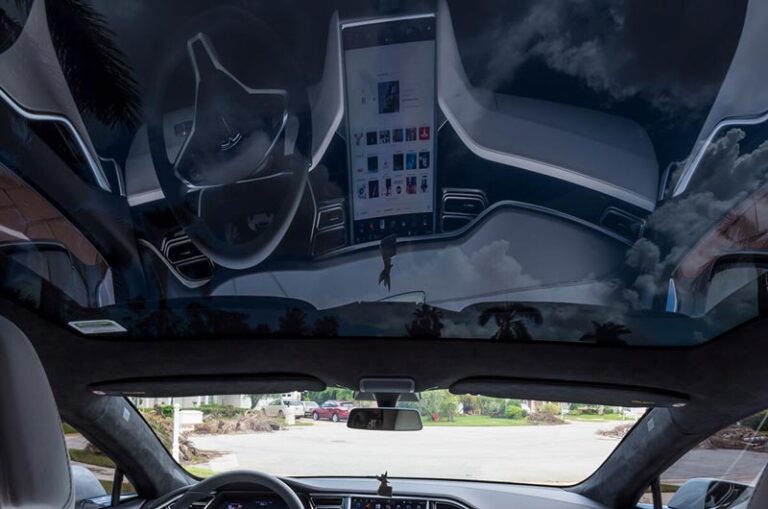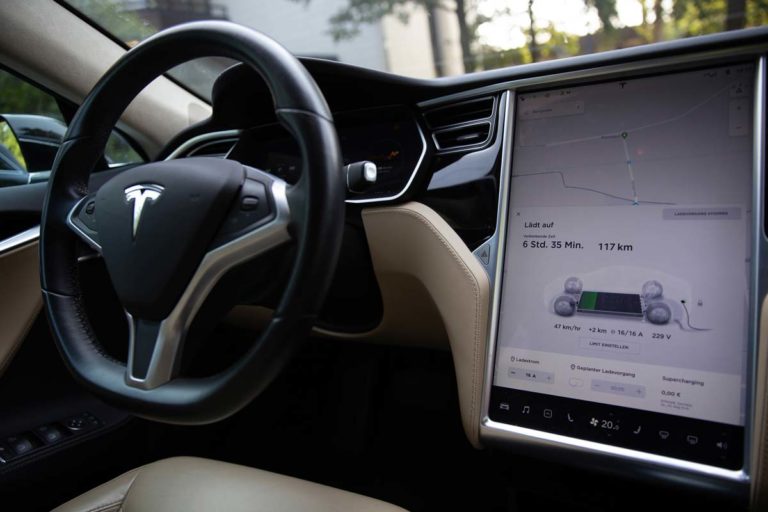When ordering a Tesla model, you have to decide whether you want an all-wheel drive or a rear-wheel drive version. But what is the difference?
A Tesla all-wheel-drive vehicle has one motor over the front axle and another over the rear axle. A Tesla rear-wheel drive has one motor over the rear axle. The all-wheel-drive Tesla delivers power to all wheels while the rear-wheel-drive Tesla delivers power to the rear wheels.
This blog post will delve deeper into all Tesla Models and the drivetrains they use. I will provide a pros and cons analysis of each system per Model. This information should help you pick the right Tesla for your situation.
- Tesla All-Wheel Drive (AWD) vs. Rear-Wheel Drive (RWD)
- Best and Worst Features of AWD and RWD in Each Model
- Is a RWD Tesla Good in Snow?
- Is the Tesla Model 3 AWD or RWD?
- Is AWD Faster Than RWD?
- How Do I Know if My Tesla Is AWD?
- Which Tesla Models Offer All-Wheel Drive (AWD)?
- What Are The Benefits Of Rear-Wheel Drive (RWD) In Electric Cars?
- How Does All-Wheel Drive (AWD) Improve Performance In Tesla Vehicles?
- Are AWD Teslas More Expensive Than RWD Models?
- Do AWD Teslas Have Better Traction In Snowy Conditions?
- Can I Switch From RWD To AWD Or Vice Versa After Purchasing A Tesla?
- How Does The Range Of AWD Teslas Compare To RWD Models?
Tesla All-Wheel Drive (AWD) vs. Rear-Wheel Drive (RWD)
Tesla uses an adaptive system when choosing how to distribute power. For instance, when accelerating hard, the onboard computer sends most power to the rear motor to launch the vehicle forward. The car’s still an all-wheel-drive car, but in some ways, it acts like a rear-wheel vehicle.
The AWD system in a Tesla typically delivers power to all wheels. The RWD system sends power to the rear wheels.
The power delivered to each wheel in an AWD Tesla might not be equal, but at all times each wheel shares a portion of the power.
Similarly, the power sent to each rear wheel in an RWD Tesla might not be equal, but each rear wheel always gets some power.

Best and Worst Features of AWD and RWD in Each Model
To better understand how each system works on Tesla, we’ll look at each Model and the system it uses.
At the moment, only the Model 3 rear-wheel drive and Model Y rear-wheel-drive standard range offer rear-wheel action. All other Model 3’s and Model Y’s, the Model X, and Model S use all-wheel drive.
Model Y
You can have a Tesla Model Y with all-wheel drive or with rear-wheel drive.
However, the Model Y rear-wheel-drive standard range is only available in China. Tesla launched the standard range in China in late August 2021.
Tesla has teased a Long Range Rear-Wheel Drive version of the Model Y, but it is yet to arrive.
Model Y All-Wheel Drive (Long Range and Performance)
The Model Y fills the void between the Model 3 and Model X. It has a bigger interior, seven seats, and more space to carry your cargo.
The Model Y versions available all around the world are the Long Range and The Performance option. The Performance option is about $4K pricier than the Long Range.
In return for the extra dollars, you get better acceleration and top speed. Unless you need the Tesla for track days, the Performance option doesn’t seem worth it.
The Performance option also has about 20 miles (32.2 km) of range less than the Long Range. Its extra focus on acceleration uses more power, eating up the miles.
The all-wheel-drive option in these vehicles certainly helps in off-road terrain. With power going to all wheels and Tesla’s intelligent power distribution system, you won’t get stuck at all.
All-wheel drive coupled with a higher ground clearance makes the Model Y the go-to option for off-road performance.
Pros
- They offer over 300 miles (482.8 km) of range on a full charge.
- The Performance is a fun car to drive.
- The extra cabin space can come in handy.
- The all-wheel-drive system works well in snow and dirt.
Cons
- The Performance option is very expensive.
Model Y Standard Range Rear-Wheel Drive
Thanks to Elon Musk, we never quite knew whether the Model Y Standard Range RWD would arrive.
Musk stated that Tesla wouldn’t produce the Model Y Standard Range vehicle because he didn’t like its under 250-mile (402.3 km) range. Contrary to Musk’s assertion, Tesla introduced the car in January 2021.
After a few weeks, Tesla abandoned the vehicle as it disappeared from the website. However, Musk stated that the car’s still available on special order.
Tesla usually withdraws such versions after a while, but the company doesn’t appear to want to let go of the Model Y Standard Range RWD. Musk now opines that the Model Y Standard Range meets Tesla’s “standard of excellence.”
In early August 2021, Tesla launched deliveries of the Model Y Standard Range RWD in China.
Pros
- It is the cheapest Model Y available.
- Its 240 miles (386.2 km) range should comfortably cover urban commutes.
- The RWD system provides more fun on the track.
Cons
- It is only available in China.
- Export costs from China increase the car’s overall cost.
- Its RWD system can struggle in off-road environments.
- The version’s future remains uncertain.
Model 3
Tesla initially named Model 3’s rear-wheel-drive version the Standard Range Plus. In early 2021, it changed the name to Model 3 Rear Wheel drive.
The name change comes with several improvements, which we will discuss below.
The other model 3’s — Long Range and Performance — use all-wheel-drive systems.
Model 3 All-Wheel Drive (Long Range and Performance)
The Model 3 is the cheapest Tesla Model available, but its low price doesn’t make it any less exciting.
As the name suggests, the Long Range offers the longest range at around 350 miles (563.3 km). The Performance version offers about 20 miles (32.2 km) less range at full charge.
The Performance version claws back some pride with its acceleration figures. It is more than a second faster to 60 mph (96.6 kph) than the Long Range.
That extra grunt of the line consumes more power, reducing range.
The Model 3 is a four-door sedan, so you don’t get as much space as you would in a Model Y. However, the absence of an engine means there’s plenty of room to store your luggage.
The cars’ all-drive system works wonders in snowy or off-road conditions.
Pros
- The versions offer long range at a reasonable price.
- The Performance slightly disappoints with its range.
- The vehicles’ all-wheel-drive system will assist you in snowy or muddy terrain.
Cons
- Space can sometimes prove to be limited.
Model 3 Rear-Wheel Drive
Tesla’s US website currently features the Model 3 Rear-Wheel Drive. It replaces the Standard Range Plus.
It has received ten miles more range, which now stands at 267 miles (429.7 km). The acceleration time has increased from 5.3 seconds to 5.8 seconds.
Other than the name and a couple of stats, nothing else has changed. Its base price is slightly above $40,000, and it has a top speed of 140 mph (225.3 kph).
Pros
- It offers the best value for money.
- It’s fun to drive on track.
- It offers decent luggage space.
Cons
- The rear-wheel-drive system can prove problematic off-road.
Model S
All Model S vehicles manufactured since 2017 come with an all-wheel-drive system.
The Model S comes in two versions, Long Range and Plaid.
The Long Range offers more miles of range but is slower than the Plaid to 60 mph (96.6 kph).
The Model S is Tesla’s equivalent of a luxury sedan. It is fast, spacious, and features a sleek exterior.
The Model S Plaid comes with Tesla’s Tri-Motor system. The Long Range uses a Dual-Motor System.
You’ll need to fork out an extra $20K to buy the Plaid. Granted, that’s a lot of money; but, depending on what you are looking for, the Plaid might be worth it.
The Plaid has a 200 mph (321.9 kph) top speed compared to the Long Range’s measly 155 mph (249.4 kph). The Long Range gets to 60 mph (96.6 kph) at an impressive 3.1 seconds, but it doesn’t compare to the Plaid’s 1.99 seconds.
The Tri-Motor’s purpose is to increase Tesla’s power. Judging by the stats, Tesla has hit its goal.
Pros
- The Model S AWD offers supreme luxury.
- The Model S Plaid AWD has increased power brought by Tesla’s Tri-Motor Technology.
- Both Model S versions offer a decent range.
- The AWD system should handle most types of terrain.
Cons
- The Model S Plaid AWD is too expensive.
Model X
Like the Model S, all Tesla models available for manufacture use all-wheel-drive systems. Tesla had planned to sell rear-wheel-drive models, but it didn’t.
The Model X features the iconic double-hinged falcon doors.
The standard Model X is just over $1,000 shy of $100K. It maxes out at 155 mph (249.4 kph) and will get to 60 mph (96.6 kph) in 3.8 seconds.
Its Plaid version utilizes a Tri-Motor and is around $10K more expensive than the standard dual-motor Model X. It will get to 60 mph (96.6 kph) in 2.5 seconds and max out at 163mph (262.3 kph).
The Model X is a heavy vehicle, and even with a Tri-Motor system, it can’t go as fast as the Model S.
It is, nevertheless, exhilarating to drive, as you can see by the following YouTube video:
Pros
- It incorporates a stylish and modern design.
- It has plenty of luggage space.
- Both versions offer over 330 miles (531 km) of range.
- The car will handle most types of terrain.
Cons
- The Model X is very expensive.
Is a RWD Tesla Good in Snow?
Elon Musk keeps answering questions about Tesla’s rear-wheel-drive performance in snow. Snow is slippery and offers little traction, which can be a nightmare for a rear-wheel-drive car.
The RWD Tesla is good in snow. It handles well, and even though all the power is at the back, the car rarely gets stuck. Tesla’s intelligent power delivery system will deliver enough power to both wheels to keep you safely stuck on the road.
Tesla Canadian Dad, a YouTuber, opines that if it’s your first time driving in the snow in a rear-wheel Tesla, find a parking lot and test how your car reacts. He states that the Tesla feels different from other cars he’s driven, but it handles the snow well.
You can find out more about what Tesla Canadian Dad has to say about Teslas in the following YouTube video:
Additionally, this YouTube video by Rocky Mountain Tesla will offer you a better understanding of Tesla’s rear-wheel-drive performance on snow and ice.
Is the Tesla Model 3 AWD or RWD?
The Model 3 is the cheapest Tesla model available, making it quite popular. It offers a decent range, and being an electric car, it is pretty fast off the line.
The Tesla Model 3 comes in both all-wheel-drive (AWD) and rear-wheel drive (RWD). The Long Range and Performance versions use all-wheel-drive. The Model 3 RWD uses rear-wheel drive, hence the “RWD” in the name.
| Model | Drivetrain | Range |
| Model 3 RWD | RWD | 267 miles (429.7 km) |
| Model 3 Long Range | AWD | 334 miles (537.5 km) |
| Model 3 Performance | AWD | 315 miles (506.9 km) |
The Model 3 RWD is an updated version of the Tesla Model 3 Standard Range Plus. The RWD offers a longer range but is slower to 60 mph (96.6 kph).
Tesla’s move has sparked rumours that the company might reintroduce the Model 3 Long Range rear-wheel-drive version. Nothing’s confirmed yet, however.
Is AWD Faster Than RWD?
In petrol-powered cars, AWD vehicles are generally faster in acceleration compared to rear-wheel cars. The AWD will accelerate faster from a standing start as all power goes to four wheels, effectively eliminating wheel spin. A rear-wheel vehicle might struggle to deal with all the power dumped on the back wheels, leading to wheel spin.
Tesla AWD is faster than RWD. Tesla stats show that all-wheel cars accelerate faster. A Tesla all-wheel car will also outpace a rear-wheel car on track as power to all the wheels keeps the car planted, even around corners. Rear-wheel Teslas tend to oversteer on track.
Car enthusiasts will tell you that oversteer isn’t a bad thing. I agree. However, if you’re after fast lap times, the AWD system is the one for you.
How Do I Know if My Tesla Is AWD?
Sometimes, it can get difficult to tell whether the Tesla you have is an AWD or a rear-wheel drive. With so many versions coming and going, it can get confusing.
If your Tesla is AWD, the car’s information from the Tesla App will read Dual Motor or Tri-Motor. You can also access car information from your car’s touchscreen.
Which Tesla Models Offer All-Wheel Drive (AWD)?
The Tesla all-wheel drive (AWD) system is designed to provide better handling and traction, especially in challenging weather conditions.
Compared to rear-wheel drive (RWD), AWD offers more stability, making it an excellent option for those who want a car that can handle different terrains and driving situations.
All current Tesla models offer an option of all-wheel drive (AWD): the Model S, Model X, Model 3, and Model Y.
With AWD, these cars can accelerate faster and have better grip than their RWD counterparts. Plus, the added benefit of dual motors means that power is distributed evenly between the front and rear wheels, helping improve efficiency while still maintaining impressive performance capabilities.
What Are The Benefits Of Rear-Wheel Drive (RWD) In Electric Cars?
Having a rear-wheel drive in an electric car can provide better handling and more precise control on the road. Tesla’s rear-wheel drive (RWD) models, such as the Model S and Model 3, have been praised for their smooth acceleration and nimble handling.
In addition to improved handling, RWD electric cars also tend to be more energy-efficient than all-wheel drive (AWD) models. This is because AWD requires additional mechanisms, such as extra motors or gearboxes, which can add weight and decrease efficiency.
However, it’s worth noting that Tesla’s AWD models still offer impressive performance and range despite this added complexity.
Ultimately, whether you prioritize precision handling or maximum efficiency will depend on your personal preferences and driving habits.
How Does All-Wheel Drive (AWD) Improve Performance In Tesla Vehicles?
If you’re looking for improved performance in your electric car, opting for all-wheel drive could be the right choice.
Tesla’s all-wheel drive system can deliver more power to the wheels with better traction, which translates to faster acceleration and better handling on slippery roads.
Are AWD Teslas More Expensive Than RWD Models?
Opting for a vehicle with all-wheel drive comes at an additional cost compared to its rear-wheel drive counterpart. The same goes for Tesla vehicles.
If you’re considering purchasing a Tesla, you’ll find that AWD models are more expensive than RWD models because AWD Teslas have an extra motor, which adds to the overall cost of the vehicle.
However, if you live in an area with harsh weather conditions or frequently encounter slippery roads, it’s worth considering investing in an AWD Tesla. The added traction and stability provided by AWD can make a significant difference in your driving experience and safety on the road.
Do AWD Teslas Have Better Traction In Snowy Conditions?
Get better traction and stay safe on snowy roads with an AWD Tesla. If you live in an area that experiences snowy conditions, you know how treacherous it can be to drive on the roads. The tires struggle to grip the slippery surface, and if you don’t have enough traction, your car could skid or spin out of control.
This is where a Tesla with all-wheel drive (AWD) can be a game-changer. Unlike rear-wheel drive (RWD) Teslas, AWD models send power to all four wheels simultaneously, allowing for better traction and stability on slippery surfaces like snow-covered roads.
The system automatically shifts torque between the front and back wheels as needed, ensuring maximum grip even in the harshest winter conditions.
Can I Switch From RWD To AWD Or Vice Versa After Purchasing A Tesla?
You may be wondering if it’s possible to switch between different types of Tesla drivetrains, such as AWD and RWD, after purchasing your vehicle. Unfortunately, the answer is no. Once you’ve chosen either an AWD or RWD Tesla, that will be the only drivetrain option available for your specific model.
This means that if you purchased an RWD Model 3 and later decide that you’d prefer the added traction and stability of an AWD Model 3, you would need to sell your current vehicle and purchase a new one with the desired drivetrain.
How Does The Range Of AWD Teslas Compare To RWD Models?
The difference in range between AWD and RWD Tesla models is something you should definitely consider when making a purchasing decision.
The all-wheel drive option typically has a slightly lower range compared to the rear-wheel drive model because the added weight of the second motor and drivetrain takes away from some of the battery’s capacity.
However, this difference in range may not be significant enough to sway your decision if you live in an area with mild weather conditions and don’t need the extra traction that comes with AWD.
On the other hand, if you live in an area with harsher weather conditions or frequently travel on unpaved roads, then the AWD option might be more suitable for your needs.
The added traction can improve handling and stability, which could potentially make up for any loss of range.
Check out these 20 great gift ideas for yourself or a Tesla fanboy.
Contact Us if you have any questions or queries.








